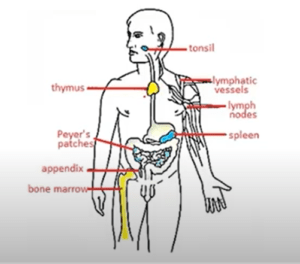Curriculum
- 1 Section
- 6 Lessons
- 10 Weeks
- Biology Human Health and Disease Class 126
- 1.1Biology Human Health and Disease Class 12 Part 1
- 1.2Biology Human Health and Disease Class 12 Part 2
- 1.3Biology Human Health and Disease Class 12 Part 3
- 1.4Biology Human Health and Disease Class 12 Part 4
- 1.5Biology Human Health and Disease Class 12 Part 5
- 1.5Biology Human Health and Disease Class 12 Part 6
Biology Human Health and Disease Class 12 Part 5
IMMUNE SYSTEM IN THE BODY
Immune system consists of-
• Lymphoid organs
• Lymphoid tissues
• B- cells and T-cells
• Antibodies
Primary Lymphoid Organs:
In primary lymphoid organs, immature lymphocytes differentiate to mature ones into an antigen sensitive lymphocytes and after maturation, lymphocytes migrate to secondary lymphoid organs.
These are of two types:
(a) Bone marrow
(b) Thymus
Bone Marrow:
It is the main lymphoid organ, where all the lymphocytes and all the body cells are produced and T-lymphocytes are developed.
Thymus:
It is a lobed organ, located near the heart and beneath the breast bone. It is large at the time of birth but with age, the size keep on reducing and becomes very small by attaining puberty. Growth and maturation of T-lymphocytes takes place in thymus only.
Secondary Lymphoid Organs:
These organs provide the sites for the interaction of lymphocytes with the antigen, which then proliferate to become effector cells.
These are of following types:
(a) Spleen,
(b) Lymph nodes,
(c) Mucosal associated Lymphoid Tissue (MALT)
Peyer’s patches of small intestine and appendix are also some of the secondary lymphoid organs.
Spleen:
It is a large bean-shaped organ containing lymphocytes and phagocytes. It filters the blood by trapping the pathogens in it.
Lymph Nodes:
These are small solid structures located at different points along the lymphatic system. Their function is to trap the microorganisms or other antigens, that enter the lymph and tissue fluid.
Mucosal Associated Lymphoid Tissue (MALT):
This is located within the lining of main tracts in the body like respiratory, digestive, urogenital tracts. MALT constitutes about
50% of the lymphoid tissue in human body.

AIDS
The term AIDS stands for Acquired Immuno Deficiency Syndrome.
The disease is acquired during life time.
AIDS is caused by human immunodeficiency virus (HIV).
HIV is a retrovirus having RNA as the genetic material.
Mode of transmission-
- Sexual contact with infected persons.
- By transfusion of contaminated blood and blood products.
- By sharinginfected needles as in the case of intravenous drug abusers.
- From infected mother to her child through placenta.
Life cycle of HIV
- After getting into the body the virus enters into macrophages or T-helper cells.
- The viral RNA genome replicated to form viral DNA with the enzyme called reverse transcriptase.
- The viral DNA gets incorporated into the host cell’s DNA and directs the infected cells to produce virus particles and the macrophages continue to produce virus.
- Viruses released from macrophages attack T-helper cells and cause a progressive reduction in the number of T-helper cells and due to which the person starts suffering from infections with several other microorganisms.
- Diagnosed by ELISA (enzyme linked immune-sorbent assay).
- Treated with anti-retroviral drugs but that is only partially effective.
Prevention of AIDS-
• To follow safe blood transfusion.
• To use disposable needles.
• To distribute free condoms.
• To prevent drug abuse.
CANCER
- Cancer is the uncontrolled cell division leading to the formation of a mass of cells called as a tumor.
- Contact inhibition is the property of normal cells by virtue of which contact with other cells inhibits their uncontrolled growth.
- Cancer cells lost the property of contact inhibition and as a result of this, cancerous cells continue to divide giving rise to masses of cells called tumors.
- Tumors are of two types: benign and malignant.
- Benign tumors normally remain confined to their original location and do not spread to other parts of the body.
- The malignant tumors are a mass of proliferating cells called neoplastic or tumor cells.
- Malignant tumors grow very rapidly and invade and ultimately damage surrounding tissues.
- The property by which cancer cells moves to distant places from their origin by blood and invade the normal cells and make them cancerous is called as metastasis.
Causes of cancer-
• Transformation of normal cells into cancerous cells may be induced by physical, chemical or biological agents called as carcinogens.
• Physical carcinogens- ionizing radiation like X-rays, gamma rays and non-ionizing radiations like UV radiation of sun.
• Chemical carcinogens- tobacco smoke and some other chemicals.
Biological carcinogens-
1. Cancer causing viruses are called oncogenic viruses have genes called viral oncogenes.
2. Cellular oncogenes or proto-oncogenes in normal cells, when get activated lead to oncogenic transformation of normal cells.
Detection of cancer-
- Biopsy and histo-pathological study of the tissues.
- Radiography by using X-rays, CT (computed tomography).
- MRI (magnetic resonance imaging).
- Use of antibodies against cancer-specific antigens.
Treatment of cancer-
- Surgery
- Radiation therapy.
- Chemotherapy
- Biological response modifiers- alpha-interferon which activate the immune system and help in destroying the tumor.